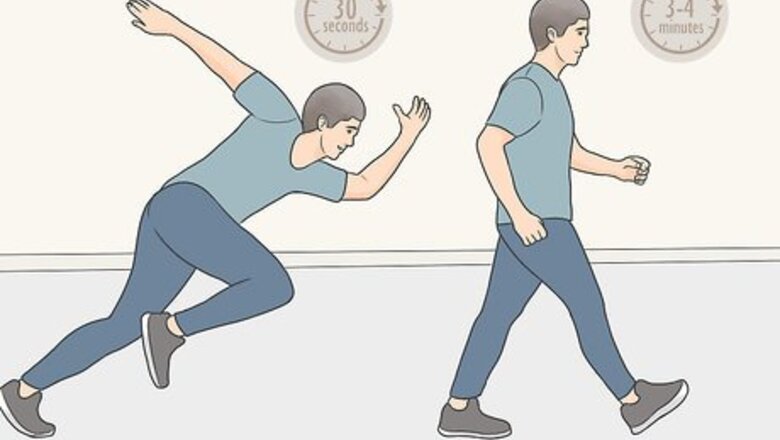
views
Strengthening Your Muscles
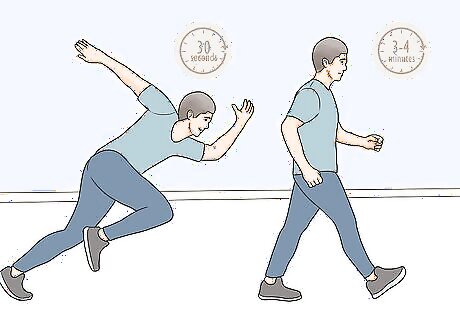
Try interval training to get the most out of your workouts. Interval training involves alternating between short high-intensity and long low-intensity activities to make your workouts more effective. When you develop your workout routine, look for activities that push your limits and are difficult to complete and plan to do them in 30-second bursts. Then choose less strenuous activities and complete them for 3-4 minutes at a time. For example, you may incorporate 30 seconds of jogging or sprinting followed by 3-4 minutes of brisk walking. Continue alternating between them until you finish your workout. Aim to exercise at least 4-5 days each week with interval training. Interval training also allows you to burn more calories than a regular workout.
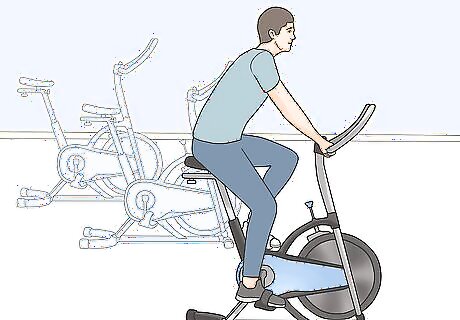
Practice cardio exercises to increase your endurance. Doing frequent cardio workouts prevents you from getting winded during a fight and boosts how long you last against your opponent. Incorporate exercises such as running, swimming, or cycling into your weekly routine so you can stay fit. Start with a 10-minute warmup so you can prepare for the rest of your workout before switching to higher-intensity exercise to keep your heart rate in your target range. Aim to do cardio for 45-60 minutes at least 2-3 times per week. If you’re at a gym or have the equipment, you can also include using a treadmill, elliptical, rowing machine, or stepping machine for your cardio workout.
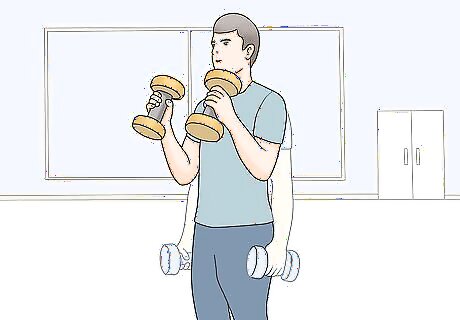
Build your arm muscles by doing curls with low weights. Strengthening your arms allows you to throw more powerful punches and block hits better. Keep your arms straight down at your sides and hold dumbbells in each hand. Make sure the weight of the dumbbells is easy for you to lift repeatedly without getting tired. Bend your arms at the elbow to curl the weights up to your shoulders in controlled motions. Slowly lower your arms back down to your sides to complete the rep. Aim to do 3 sets of 15-20 reps for your workout.Tip: Using heavy weights will increase your muscle mass more, but using light weights help you build up your speed and get more power from your hits.
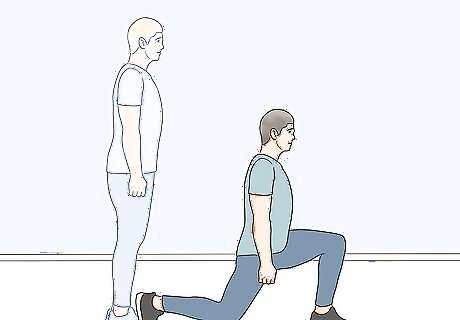
Exercise your legs and core by doing lunges. Stand up straight with your arms at your side and take a large step forward with one foot. As you step forward, bend your knees until your front leg forms a 90-degree angle. Pause for 1 count before standing upright again. Alternate which leg you use after each lunge to get a balanced workout. Do 2-3 sets of 10-15 lunges. You can choose to do lunges with your bodyweight or you can hold dumbbells to make them more difficult.
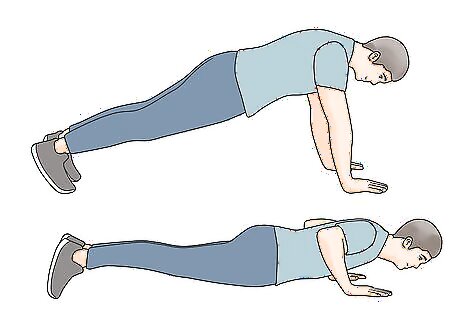
Do push-ups to develop your arms and core. Lay in a plank position on the floor and plant your palms are slightly wider than your shoulders. Straighten your arms to raise yourself off the ground so your back stays straight. Lower yourself slowly toward the ground until your elbows form a 90-degree angle and hold the position for 1 count. Straighten your arms again to raise your body in a slow, controlled motion. Aim to do 2-3 sets of 15-20 push-ups for your workout. If standard push-ups are too hard, put your knees on the ground to make them easier. If you want to make your push-ups more difficult, move your body in a circular motion as you lower yourself to the ground to activate your core even more.
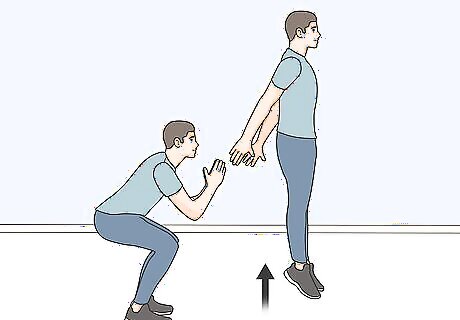
Incorporate jump squats into your routine to exercise your legs. Stand so your back is straight and your feet are slightly wider than shoulder-width apart. Bend your knees until they form a 90-degree angle to lower your body closer to the ground while you keep your back straight. Hold the position for 1 count before straightening your legs to jump off the ground. As soon as you land, start going into your next squat. Do 2-3 sets of 15-20 jump squats to get a good leg workout. Building up your leg strength allows you to move more quickly and throw more powerful kicks. Squat using 1 leg at a time if you want to make them more difficult. You can choose to do bodyweight squats or hold dumbbells if you want to increase the weight.
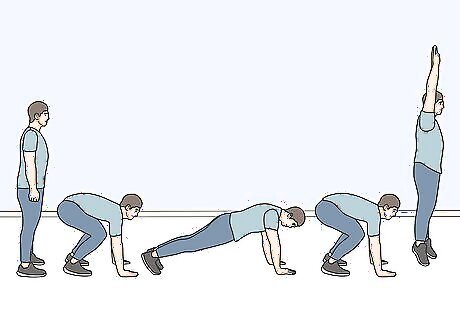
Practice doing burpees to get a full-body workout. Stand with your feet shoulder-width apart and your arms at your side. Keep your back straight as you bend your knees until they’re at a 90-degree angle. Plant your palms on the ground in front of you and move your feet behind you to get into a plank position. Lower your body until your elbows are at a 90-degree angle before jumping back up into a squat. Jump in the air to straighten your legs and start your next squat immediately when you land. Aim to do 2-3 sets of 10-15 burpees.
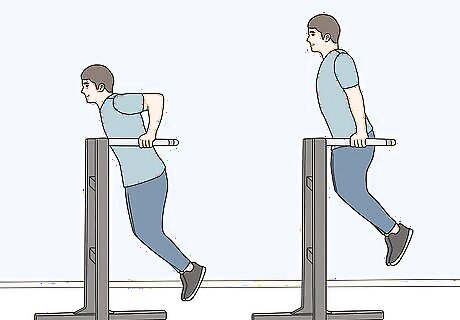
Do dips to work out your arms, chest, and back. Hold your body up on parallel bars so your arms are fully extended and your feet are off the ground. Bend your elbows until they’re at a 90-degree angle to lower your body and activate your chest, back, and tricep muscles. Hold the pose for 1 count before lifting yourself back up again. Try doing 2-3 sets of 10-15 reps when you do dips. Wear a weighted belt or ankle weights if you want to make the exercise more difficult. If you don’t have access to parallel bars, you can also do dips using a bench instead.
Practicing Fighting Techniques
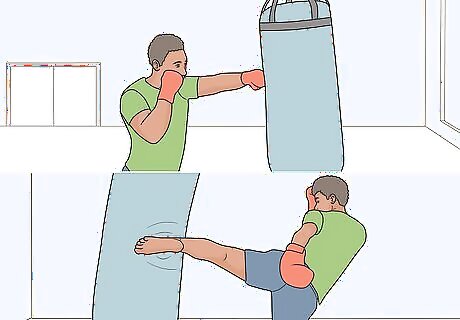
Take self-defense or martial arts classes if you want to learn a specific style. Studying a specific form of self-defense or martial arts allows you to focus on a single method of fighting so you can master the techniques. Taking a class also lets you have a coach or trainer that can help you with your form and give you additional tips. Look for martial arts or self-defense classes in your area and look into the style that they teach. Choose a style that best fits your needs for fighting. Pick boxing if you want to focus on footwork and punches. Try Muay Thai, or kickboxing, to incorporate punches and kicks into your fights. Practice Brazilian jiu jitsu if you want to try takedowns and grappling. Choose karate if you want to practice a more traditional martial art.
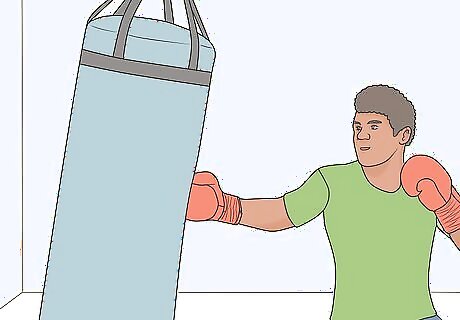
Practice throwing punches on a punching bag. Punching is one of the most common techniques in fighting and is used in all forms of martial arts. Stand within arm’s reach of the punching bag, and make your hands into tight fists in front of your face. When you throw a punch, twist your hips toward your opponent and extend your arm straight out in front of you. Quickly pull your arm back in front of your face so you can defend yourself. When you’re in a fight, aim for your opponent’s face or stomach since these are vulnerable areas. If you want to try throwing a hook, lock your wrist and swing at your opponent from the side. Alternate which arms you punch with to practice putting them together into different combinations.Tip: If you don’t have a punching bag, practice shadow boxing to improve your form and technique. You can try shadow boxing with weights as well if you want to make it more of a workout.
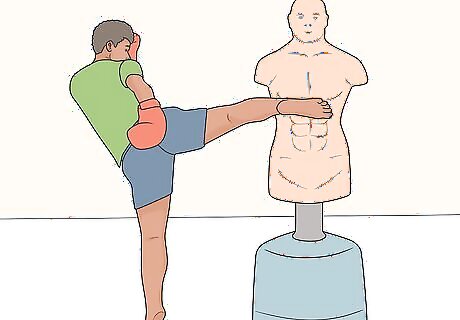
Work on body kicks so you’re more versatile in a fight. Stand with your nondominant leg in front of you and your body turned to the side. Twist your nondominant foot away from your other leg to spin your body toward your opponent. As you spin, lift your dominant leg and aim your kick with your knee. Just as you’re about to make contact, extend your dominant leg straight to get the most power. Practice kicking at different heights on a punching bag or dummy so you can land kicks on your opponent’s chest or head.
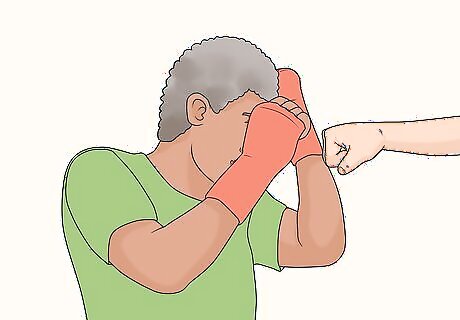
Learn how to block hits so you don’t get hurt as much. Protect your head from punches and kicks by keeping your arms up in front of your face. When you see your opponent coming for a hit, tuck your head down closer to your chest and use your forearms to deflect the hit. Make sure you always keep your eyes on your opponent so you can watch their next movement and prepare for the attack. Alternatively, if your opponent swings at you, you can try pushing your forearm into the crook of their elbow to prevent the blow from hitting you. This works well if your opponent is attacking you with a weapon.
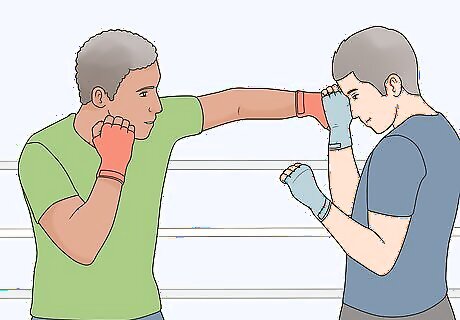
Find a sparring partner if you want to practice fighting with another person. While practicing with a punching bag or a dummy works well for developing technique, fighting against a human opponent can help you get real experience. Ask other people that you train with or a coach to spar with you so you can work on blocking hits and protecting yourself. Don’t use your full power while you’re sparring with someone since you could seriously injure them.
Adjusting Your Diet
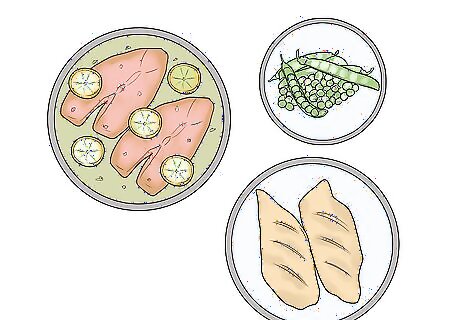
Include protein in your diet to promote healthy muscle growth. Protein is an important nutrient that supports your bone and muscle health so you stay strong. Look for lean sources of protein, such as fish, chicken, eggs, and beans, to include in your diet so your muscles continue to grow. When you choose to snack, look for high protein options, such as Greek yogurt, jerky, or nuts. To determine how many grams of protein to include in your diet, multiply your body weight in pounds by 0.36. For example, a person that weighs 130 pounds (59 kg) needs 46.8 grams of protein.

Eat dark leafy greens and vegetables to get the nutrients you need. Dark leafy greens, such as spinach, kale, and arugula, all provide you with vitamins and minerals that are important for promoting heart health so you can last longer in a fight. You can also include other vegetables, such as onions, tomatoes, broccoli, and carrots into your diet for additional vitamins and minerals. Aim to have about 2-3 servings of vegetables each day so you can stay healthy. Try other vegetables in your diet, like brussel sprouts, asparagus, and peppers for additional nutrients. Vegetables can also give you more energy so your endurance is higher while you’re fighting.

Choose complex carbs instead of simple carbs. Complex carbs haven’t been stripped of nutrients or vitamins and offer a healthier option than refined carbs. Look for whole grains, such as wheat bread, wild rice, or quinoa and include at least 2-3 servings of them in your diet each day. You can also get carbs from fruits and vegetables, dairy products, and nuts. Avoid processed foods and sugars since they aren’t as nutritious as other meals.

Incorporate healthy fats into your diet. Healthy fats give you more energy and help reduce your hunger and help you lose weight if you’re trying to get fit. Healthy fats include peanut butter, avocados, salmon, beans, and nuts, so you can incorporate them into any meal throughout the day. Try to include about 45-75 grams of healthy fats into your diet each day so you can continue getting the nutrients you need. Avoid having food high in trans fat or saturated fat, such as fried foods, butter, red meat, and salty snack foods.

Drink water so you stay hydrated. Training for a fight can cause you to sweat and lose water, so it’s important to replenish your body so you don’t get dehydrated. Aim to have at least 12 cups (2.8 L) of water a day to maintain a healthy level in your body. You may need to have more water each day depending on the weather and how intense you’re training. Avoid having sugary or caffeinated drinks since they can dehydrate you more.













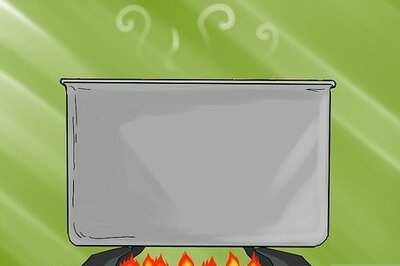






Comments
0 comment